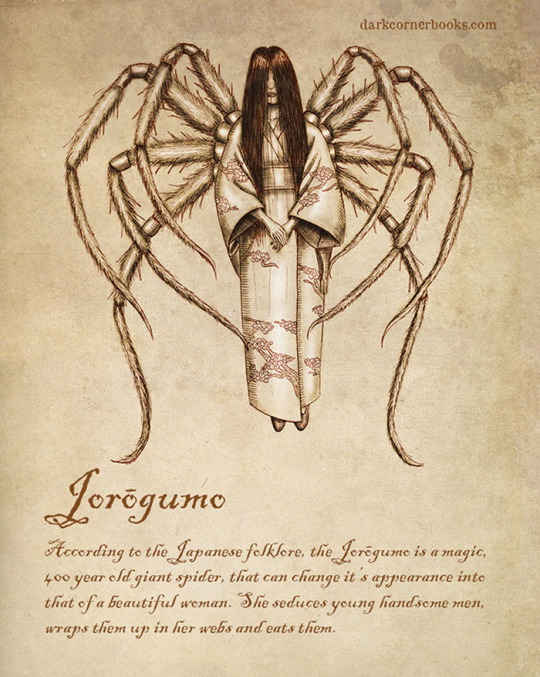#jorō-gumo
Explore tagged Tumblr posts
Text

By Christina Butler from Georgia, United States - [Joro Spider - Trichonephila clavatamlqooppsulhq Lidl HK go ñ km.], CC BY 2.0
#joro-spider#joro spider#jorō-gumo#spider#arachnid#i saw a spider similar to this last summer i think but i don't believe we have them this far north. so probably some kinda orb weaver
49 notes
·
View notes
Text

this morning i watched a sinéad o'connor video, saw a lone joro spider, and went full looney tunes running through the mud in the middle of the woods
#rambles#jorō-gumo#night flight#shapeshifters#widowmakers#the wing is broken off of this one and glued back on#uncontrollable fits of conversational aposiopesis#you throw a rotten pear under the hanging tree for the squirrels to fight over#north fulton county#georgia
24 notes
·
View notes
Text

【庭】ジョロウグモ(6月20日)
Trichonephila clavata, also known as the Joro-spider (Jorō-gumo), is a spider in the Trichonephila genus.
1 note
·
View note
Text
Xue Yang - Jorō-gumo
Song Lan - ōkami, werewolf
Xiao Xingchen - human, youkai hunter

11 notes
·
View notes
Text
Jorogumo
In Japan, some spiders are known to possess amazing supernatural powers. One of these, the jorō-gumo, known as the golden orb-weaver in English, is the most well-known of the arachnid yokai. Jorō-gumo are found all over the Japanese archipelago, except for Hokkaido. Their body size averages between two to three centimeters long, but they can grow much larger as they age; some are large enough to catch and eat small birds. These spiders are renowned for their large size, their vividly beautiful colors, the large and strong webs they weave, and for the cruel destruction they wreak on young men. Their name is written with kanji that mean “entangling bride.” However, these characters were added on to her name much later to cover up the original meaning of the name: “whore spider.”
Jorō-gumo live solitary lives, both as spiders and as yokai. When a golden orb-weaver reaches 400 years of age, it develops magical powers and begins to feed on human prey instead of insects. They make their nests in caves, forests, or empty houses in towns. They possess a cunning intelligence and a cold heart, and see humans as nothing more than insects to feed on. They are skillful deceivers and powerful shapeshifters, usually spending their lives appearing as young, sexy, and stunningly beautiful women.
Jorō-gumo’s favorite prey is young, handsome men who are looking for love. When a jorō-gumo spots a man she desires, she invites him into her home, and he is usually never seen again. They can spin silk threads strong enough to ensnare a grown man so that he cannot escape. They also have a powerful venom that can slowly weaken a man day by day, allowing the spider to savor the long and painful death her victim suffers. They can control other, lesser spiders, even employing fire-breathing spiders to burn down the homes of any who grow suspicious of them. A jorō-gumo can operate like this for years and years, even in the middle of a busy city, while the desiccated skeletons of hundreds of youth build up in her home.
The Edo period legend has it that a beautiful woman would entice a man into a quiet shack and begin to play a Biwa, a type of Japanese lute. While the victim was distracted by the sound of the instrument, she would bind him in spider silk threads in order to devour the unsuspecting person as her next meal.
According to legend, when a spider turns 400 years old, it gains magical powers. Stories of Jorōgumo can be found in Edo period works, such as "Taihei-Hyakumonogatari" (太平百物語) and "Tonoigusa" (宿直草). In many of these stories, Jorōgumo changes its appearance into a beautiful woman to ask a samurai to marry her, or takes the form of a young woman carrying a baby (which may turn out to be a spider's eggsack).
Drawings, such as the one in Toriyama Sekien's book Gazu Hyakki Yakō, depicts Jorōgumo as a half-woman/half-spider surrounded by her spider children.
A Jorōgumo is also known as the mistress of the Jōren Falls (浄蓮の滝) in Izu, Shizuoka. The legend has it that a man was resting at the foot of the waterfall when his feet were bound with a vast number of spider threads. To free himself, he cut the threads and tied them to a stump of a tree, which was pulled from the ground and drawn into the waters.
After this incident at the Jōren waterfall, the villagers became afraid and stopped going to the waterfall. However, one day, a woodsman logger from out of town, unaware of the story of the Jōren Jorōgumo, began cutting wood in the area. After he accidentally dropped his axe into the water, he dove into the pool to find it; then a beautiful woman appeared and returned the axe, telling him never to tell anyone about her. While the logger kept the promise, he began to feel anxious about the incident. One day while he was drunk, he told his secret and finally felt at ease. He then fell into a deep sleep never to awaken again.
In a variation of the story of the Jōren waterfall, the logger falls in love with the woman Jorōgumo and starts visiting the falls every day to see her. But as time passes, he starts growing weaker and weaker. A monk from a neighboring temple believes the logger has been trapped by the spider, so he and the logger go to the waterfall together, and the monk reads a Buddhist Sūtra there. While the monk reads the sutra, spider threads appear from the pool and attempt to wrap themselves around the logger, but the monk shouts his Buddhist chant and they disappear. Though the logger soon realizes that the woman was a spider, he cannot forget his love for her. He then asks for help from a Tengu, master of the Yōkai of the mountain, but the Tengu forbids this love. The logger was unwilling to give up his love for the Jorōgumo. While running back to the waterfall he is caught by the silk threads and finally falls into the water, never to surface again.
There are many stories throughout Japan of a tree stump being pulled into the water in place of the lumberjack from the previous tale. One such example is that of Kashikobuchi (賢淵), Sendai. Here, just after the stump is pulled into the pool, the lumberjack hears a voice saying, "How clever, how clever" (賢い、賢い / Kashikoi, Kashikoi). For this event, the area came to be called Kashikobuchi, which literally means "clever abyss". In Kashikobuchi, the Jorōgumo is worshiped as a goddess who protects people from drowning, and a monument and a small Torii still stand at the location.

29 notes
·
View notes
Text
The joro-spider is officially a critter!

By Christina Butler from Georgia, United States - [Joro Spider - Trichonephila clavatamlqooppsulhq Lidl HK go ñ km.], CC BY 2.0
49 notes
·
View notes